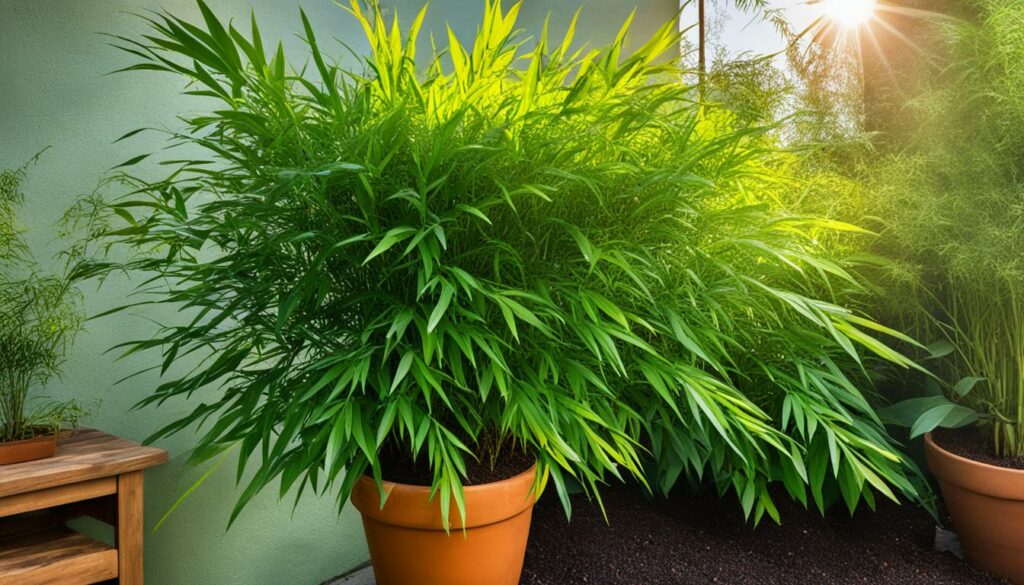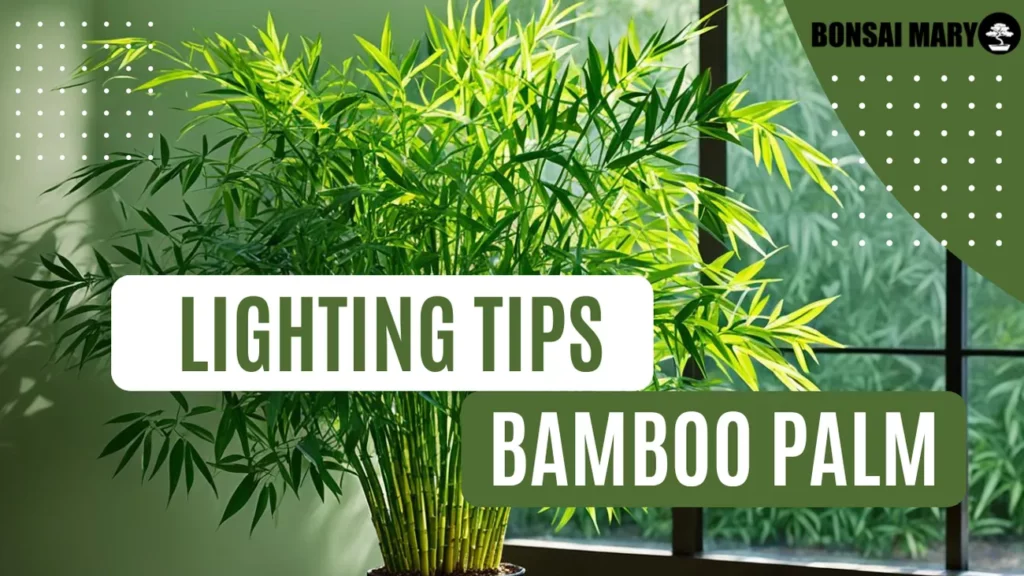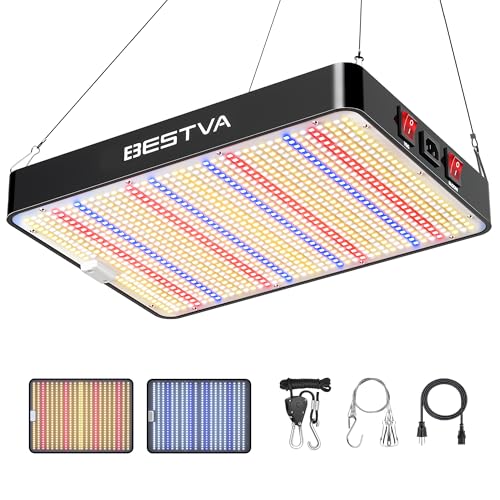Bamboo Palm requires bright, indirect light for healthy growth, but it can also tolerate lower light conditions, making it an adaptable choice for indoor spaces.
Welcome to our article on bamboo palm lighting needs for healthy growth. In this guide, we will explore the importance of proper lighting, natural light requirements, potential risks, and common mistakes to avoid.
We will also provide practical tips on supplementing with artificial lighting, managing lighting in different seasons, troubleshooting problems, and creating a lighting schedule. Let’s dive in and discover how to provide the ideal lighting conditions for your bamboo palm to thrive and flourish.
Importance of Proper Lighting for Bamboo Palm

When it comes to the growth and well-being of your bamboo palm, proper lighting is of utmost importance. Adequate light supply ensures the vitality and overall health of your plant.
Providing the right amount and quality of light allows your bamboo palm to thrive and display its full potential.
Proper lighting is crucial because it directly impacts the plant’s photosynthesis process, which is essential for energy production and growth. The right amount of light enables your bamboo palm to convert carbon dioxide into oxygen, enabling it to flourish and maintain a healthy ecosystem within your home or garden.
Bamboo palm, also known as Chamaedorea Seifrizii, originates from the rainforests of Central and South America. In its natural habitat, it thrives under the canopy of tall trees, receiving filtered light throughout the day.
Replicating this environment with proper lighting is vital to ensure the well-being of your indoor bamboo palm.
Without adequate light, your bamboo palm may exhibit signs of distress, such as stunted growth, yellowing leaves, or even leaf drop. Insufficient light can hinder the plant’s ability to carry out essential functions, leading to an overall decline in its health and appearance.
No products found.
Benefits of Proper Lighting:
- Promotes healthy growth and development
- Enhances foliage color and texture
- Improves air quality by converting carbon dioxide to oxygen
- Boosts the plant’s resilience against pests and diseases
- Creates an appealing and vibrant atmosphere in your living space
Natural Light Requirements for Bamboo Palm

To ensure the healthy growth and well-being of your bamboo palm, it is essential to understand its natural light requirements. Bamboo palm thrives best in bright, indirect sunlight.
This means that it should be placed in a location where it can receive a moderate amount of sunlight without direct exposure to harsh rays.
Indirect sunlight mimics the conditions found in its natural habitat, allowing the plant to thrive and maintain its vibrant green foliage. Placing your bamboo palm near a window with a sheer curtain or in a well-lit room can provide it with the optimal amount of natural light it needs.
Positioning for Optimal Exposure
When positioning your bamboo palm, it is important to consider its light requirements. Here are some tips to help you achieve optimal exposure:
- Place the bamboo palm within 5-8 feet of a north or east-facing window to ensure it receives sufficient indirect sunlight.
- Avoid placing the plant in direct sunlight, as this can cause the leaves to burn or wilt.
- If your bamboo palm is not receiving enough natural light, you can supplement it with artificial lighting.
- Rotate the plant every few weeks to ensure all sides receive equal light exposure and prevent uneven growth.
Indicators of Insufficient Light for Bamboo Palm

Proper lighting is essential for the healthy growth of your bamboo palm plant. However, insufficient light can hinder its development and lead to potential health issues.
By being aware of the following indicators, you can take necessary steps to address the problem and ensure your bamboo palm flourishes.
- Pale or yellowing leaves: A common sign of insufficient light is the appearance of pale or yellowing leaves. If your bamboo palm is not receiving enough light, the leaves may lose their vibrant green color and become dull or discolored.
- Stunted growth: Insufficient light can slow down the growth rate of your bamboo palm. You may notice that the plant is not reaching its expected height or that new leaves are smaller in size.
- Leggy or elongated stems: In an effort to reach for more light, the stems of a bamboo palm may become leggy or elongated. This can result in a thin and weak appearance.
- Leaf drop: If your bamboo palm is not receiving adequate light, it may start shedding leaves. Leaf drop is a common response to stress, and insufficient light can be one of the contributing factors.
- Weak root system: Insufficient light can weaken the root system of your bamboo palm, making it more susceptible to damage and disease. A weak root system can affect the overall health and stability of the plant.
To address these indicators of insufficient light, there are a few measures you can take:
- Reposition the plant: Move your bamboo palm to a location with brighter, indirect light. Find a spot near a window that provides sufficient light without direct exposure to intense sunlight.
- Use supplemental lighting: If natural light is limited, consider using artificial lighting to supplement the light requirements of your bamboo palm. Use a grow light specifically designed for plants.
- Trim or prune: If your bamboo palm has become leggy or has elongated stems, consider trimming or pruning it to encourage compact growth and stimulate new leaf development.
Potential Risks of Excessive Light for Bamboo Palm

Providing adequate light is essential for the healthy growth of your bamboo palm. However, excessive exposure to direct sunlight can pose risks to the plant’s well-being.
It’s crucial to understand and manage the potential risks associated with excessive light to ensure the longevity of your bamboo palm. Let’s explore these risks and learn how to protect your precious plant.
1. Sunburn
Excessive light can cause sunburn on the delicate leaves of your bamboo palm. Sunburn presents as brown patches, browning of leaf tips, or overall discoloration.
These signs indicate that the plant is receiving more sun than it can tolerate. To protect your bamboo palm from sunburn, consider adjusting its exposure to direct sunlight or providing shade during the peak hours of the day.
2. Leaf Scorch
Leaf scorch is another common risk of excessive light for bamboo palm. This condition occurs when the leaves lose moisture faster than they can replenish, resulting in their edges or entire surfaces appearing brown, dry, or crisped.
To prevent leaf scorch, ensure sufficient humidity in the surrounding environment, and consider relocating the bamboo palm to a spot with indirect sunlight or diffused light.
3. Stunted Growth
While bamboo palm thrives in bright light, excessive light can hinder its growth. High-intensity light can cause the plant to divert its energy towards healing sun damage rather than focusing on healthy growth.
To promote optimal growth, ensure your bamboo palm receives the right balance of light, providing enough intensity without overwhelming the plant.
4. Heat Stress
Excessive light can also lead to heat stress in bamboo palm. When the plant is exposed to intense sunlight for prolonged periods, it can experience temperature fluctuations that can impact its health and overall well-being.
To mitigate heat stress, consider relocating your bamboo palm to a spot with partial shade or use a sheer curtain to filter the direct sunlight while still allowing sufficient light for growth.
Supplementing with Artificial Lighting

If you have limited access to natural light, don’t worry! Artificial lighting can come to the rescue and provide the necessary light requirements for your bamboo palm. By using the right type of artificial lighting, you can ensure your plant receives the light it needs to thrive.
No products found.
When it comes to choosing artificial lighting for your bamboo palm, there are a few options to consider:
- Fluorescent Lights: Fluorescent lights are a popular choice for indoor plant lighting. They are energy-efficient and provide a good spectrum of light that promotes healthy growth. Place the fluorescent lights about 6-12 inches above the plant, making sure they cover the entire canopy.
- LED Grow Lights: LED grow lights are another excellent option for supplementing the light needs of your bamboo palm. They consume less energy than traditional lights, emit little heat, and can be more easily adjusted to provide the right spectrum of light. Hang the LED lights at a distance of 6-12 inches from the top of the plant for optimal results.
- Incandescent Lights: While incandescent lights can provide some light for your bamboo palm, they are not the most efficient option. They emit more heat and fewer wavelengths of light that plants require. If using incandescent lights, make sure to keep them at a distance of at least 2 feet from the plant to avoid burning the leaves.
No products found.
Common Mistakes to Avoid in Bamboo Palm Lighting

Proper lighting is crucial for maintaining the health and vitality of your bamboo palm. However, there are some common mistakes that you should avoid to ensure the optimal growth of your plant.
By avoiding these mistakes, you can provide the right lighting conditions for your bamboo palm and enjoy its lush green foliage for years to come.
1. Overexposure to Direct Sunlight
One of the most common mistakes in bamboo palm lighting is placing the plant in direct sunlight for extended periods. While bamboo palm thrives in bright, indirect light, excessive exposure to direct sunlight can lead to scorched leaves and stunted growth.
It’s essential to find the right balance and provide your plant with bright, indirect light instead.
2. Insufficient Lighting
Another mistake to avoid is not providing enough light for your bamboo palm. Insufficient lighting can cause the plant to become weak, leggy, and prone to diseases.
Ensure that your bamboo palm receives enough bright, indirect light throughout the day. If natural light is limited, you can supplement with artificial lighting sources.
3. Neglecting to Rotate the Plant
For proper and even growth, it’s important to rotate your bamboo palm regularly. Neglecting to rotate the plant can cause it to lean and grow towards the light source, resulting in an unbalanced and uneven appearance.
Rotate the plant every few weeks to ensure that all sides receive equal exposure to light.
4. Using Incorrect Light Intensity
Using incorrect light intensity can also be a common mistake. Bamboo palm requires bright, indirect light but not intense or overwhelming light.
Avoid placing the plant under extremely bright lights or in close proximity to heat-generating light sources, as this can harm the plant and cause leaf burn.
5. Failing to Adjust Lighting Based on Seasons
Seasonal changes can significantly impact the lighting needs of your bamboo palm. Failing to adjust the lighting in different seasons can lead to inadequate light exposure and hinder the plant’s growth.
Be aware of the changing sunlight patterns and make necessary adjustments to maintain consistent lighting conditions.
Managing Bamboo Palm Lighting in Different Seasons

Properly managing the lighting needs of your bamboo palm throughout the different seasons is crucial for its healthy growth and overall well-being. As the seasons change, so does the intensity and duration of natural light, impacting the plant’s light requirements.
During the summer months, when the sun is at its brightest, it’s important to protect your bamboo palm from excessive light exposure. Placing the plant away from direct sunlight or providing shade can prevent sunburn and damage to the leaves.
In contrast, during the winter months when natural light diminishes, it becomes necessary to supplement with artificial lighting. Positioning your bamboo palm near a sunny window or using fluorescent grow lights can provide the necessary light levels to sustain optimal growth.
Transition periods, such as spring and fall, require careful observation and adjustment of light exposure. In spring, gradually increase the amount of natural light your bamboo palm receives, allowing it to adjust to the brighter conditions.
Conversely, in fall, gradually decrease the amount of light exposure to help acclimate the plant to the reduced sunlight.
Troubleshooting Lighting Problems in Bamboo Palm

Sometimes, despite your best efforts, bamboo palm plants may encounter lighting problems that can affect their growth and overall health. Understanding and addressing these lighting issues promptly can help rescue the plant and restore its vitality.
1. Insufficient Light
One of the most common lighting problems for bamboo palm is insufficient light. If your plant is not receiving enough light, you may notice its leaves becoming pale or losing their vibrant green color.
To address this issue, consider repositioning your bamboo palm to a spot with brighter, indirect sunlight. Alternatively, you can supplement natural light with artificial lighting options such as LED grow lights.
Place the lights within an appropriate distance from the plant to provide the necessary light intensity.
2. Excessive Light
Excessive light exposure can also harm bamboo palm plants. If your plant shows signs of sunburn, such as brown or scorched leaves, it may be receiving too much direct sunlight.
To protect your bamboo palm, move it to a location where it can still receive bright light but is shielded from the intense rays. Consider using sheer curtains or blinds to filter the sunlight.
Remember to monitor the plant closely and make adjustments as needed to prevent further damage.
3. Uneven Light Distribution
Uneven light distribution can lead to uneven growth and health issues in bamboo palm plants. If you notice that certain parts of your plant are receiving more light than others, it is essential to address this problem.
Rotate the plant periodically to ensure all sides receive equal exposure to light. Additionally, consider adjusting the position of nearby light sources or using reflective surfaces to redirect light and create a more balanced environment for your bamboo palm.
4. Poor Light Quality
Poor light quality can negatively impact the growth and vitality of bamboo palm plants. If you suspect that the quality of light your plant is receiving is suboptimal, consider the following factors:
- Check for obstructions such as dusty leaves or nearby objects that may block light from reaching the plant. Clean the plant’s leaves regularly and remove any obstructions.
- Ensure that the light source is providing the right spectrum of light for the plant’s needs. Bamboo palm plants thrive under full-spectrum light, which simulates natural sunlight.
- If using artificial lighting, make sure the bulbs are not outdated or damaged. Replace them if necessary to maintain the proper light quality for your bamboo palm.
Creating a Lighting Schedule for Your Bamboo Palm

Establishing a proper lighting schedule is crucial for maintaining the health and growth of your bamboo palm. By providing consistent and appropriate light, you can ensure that your plant thrives and stays happy.
Follow these steps to create a suitable lighting schedule based on your bamboo palm’s unique needs:
- Assess your home’s natural light: Start by identifying the areas in your home that receive the right amount of natural light for your bamboo palm. Look for areas with bright, indirect sunlight, such as near a north-facing window or under a skylight.
- Observe the light intensity: Determine the intensity of the natural light in each potential location for your bamboo palm. Take note of how many hours of direct or indirect sunlight each spot receives throughout the day.
- Create a schedule: Based on your observations, create a lighting schedule that replicates the natural light conditions your bamboo palm prefers. Aim for 8-12 hours of bright, indirect sunlight per day.
- Consider the seasons: Keep in mind that the lighting requirements for bamboo palm may vary depending on the season. Adjust your lighting schedule accordingly to account for changes in daylight duration and intensity.
- Supplement with artificial lighting: If you don’t have access to sufficient natural light, supplementing with artificial lighting can help meet your bamboo palm’s requirements. Choose a suitable artificial light source, such as fluorescent or LED grow lights, and incorporate it into your schedule.
- Monitor and adjust: Regularly monitor the health and growth of your bamboo palm to ensure it is thriving under the lighting schedule you have created. If necessary, make adjustments to the duration or intensity of light exposure.
Conclusion
To provide the best lighting conditions for your bamboo palm, it is crucial to place it in an area with bright, indirect sunlight. Avoid exposing it to excessive direct sunlight, as this can cause harm to the plant.
Additionally, be mindful of common mistakes such as insufficient or excessive light exposure, which can hinder the growth of your bamboo palm.
By avoiding these pitfalls and addressing any lighting problems that may arise, you can maintain a beautiful and flourishing bamboo palm in your home or garden.
Remember to establish a lighting schedule that aligns with the changing seasons to support optimal growth. Supplementing with artificial lighting can also be beneficial, especially if natural light is limited.






